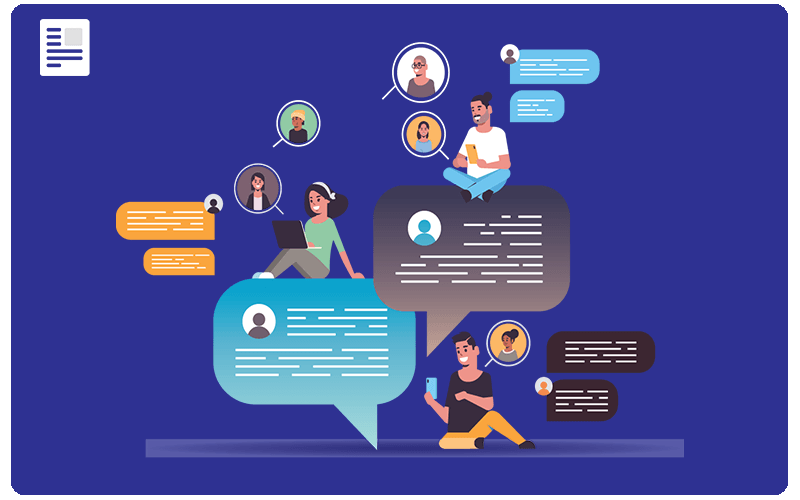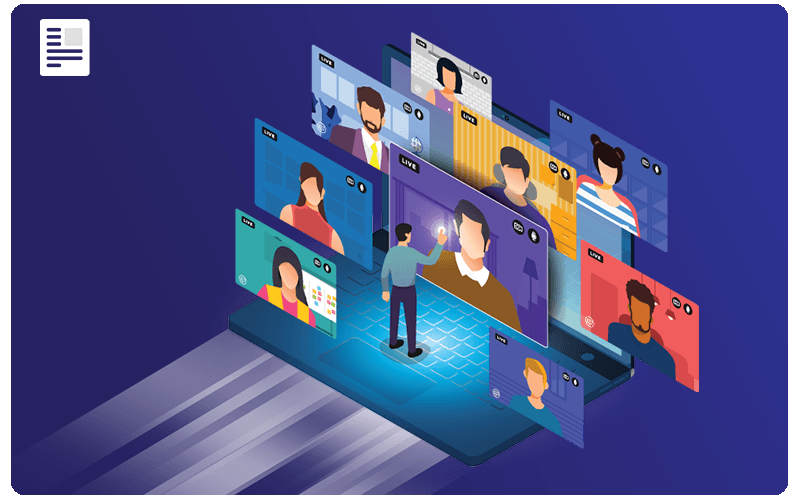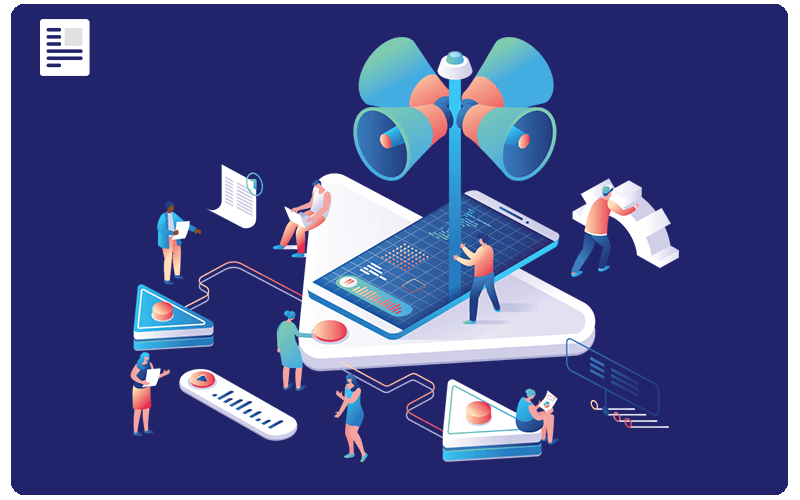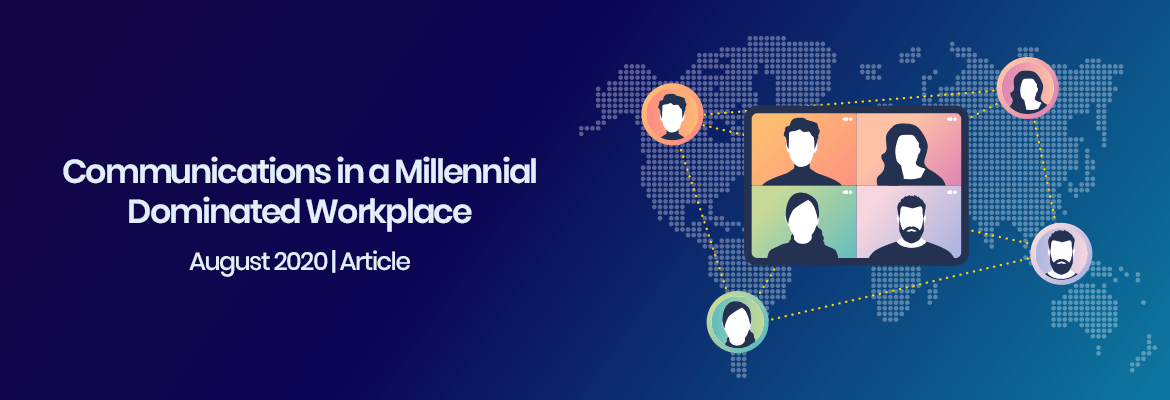
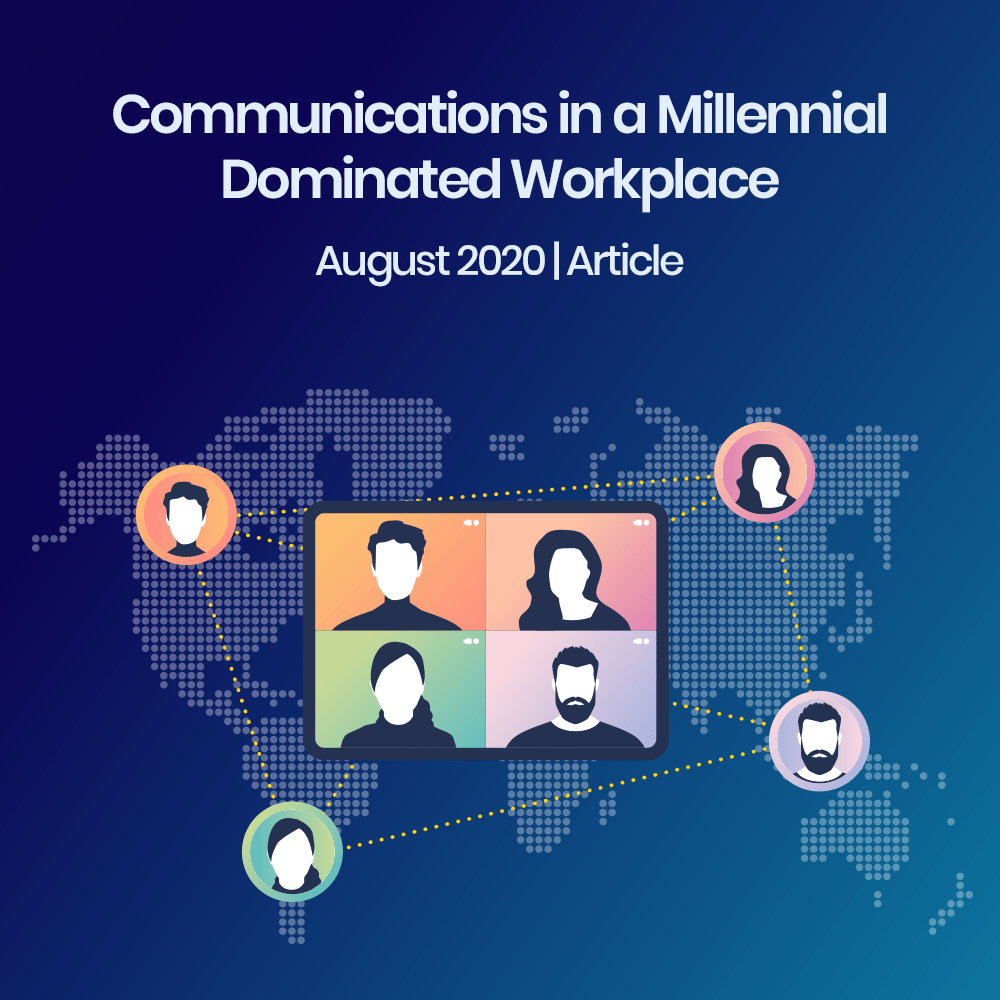
Millennials have surpassed Gen-X and Baby Boomers in being the largest American labour force participants, according to the Pew Research Center. Workforces form the core foundation of an organization and have a direct influence on an organization’s growth, corporate culture and productivity. Millennials grew up with much distinctive values, ethics and skills compared to the previous generations. They have been exposed and immersed in technology from infancy and have particularly been the first of its kind to grow up with tech as an inherent skill, making most (if not all) of them technologically literate and equipped. This makes them communicate differently compared to past generations and they also expect their employees to use modern and mobile ways to communicate. Research by TechSmith has revealed that organizations are not communicating with younger workers, with 44% of millennials who believe their company’s communications are outdated and only 29% saying they are not.
This transformation in workplace demographics and overall business dynamics drives the transition to the cloud as these fresh set of employees demand modern modes of communication. Having a digital ecosystem that enables and supports all channels of connectivity and collaboration is crucial for organizations wanting to stand out and be successful. There are several cloud-based applications and platforms to lure in the millennial tech-brain and harness the convenience of automated organizational processes. Gartner’s report on Millennial Digital Workers revealed that 42% of Millennials use real-time messaging at work, 42% use social media and 32% use storage or sharing applications. With a whole new range of tools at their disposal and cloud being their instrumental enabler— organizations need to embrace a new set of technologies to incorporate the tech-savvy and motivated generation of today to take advantage of their innovative and fresh ideas. The cloud helps bridge the gap between organizations and their employees by offering tools that support remote work through team collaboration, project management, videoconferencing, document sharing and chat apps.
Inclusive remote work
The mobile workforce is expanding rapidly and organizations are looking to incorporate the transformative benefits of a decentralised workplace. A new wave of millennials and Gen Z-ers with a different set of values and work ethic are set to enter the workforce and one way to satisfy their expectations is to have remote work technology in place. Employers who provide flexible work options for their workforce will be able to attract and retain more millennial employees. ManpowerGroup’s research on Millennial Careers concluded that 79% of millennial’s prioritize flexible working when looking for a job. Since reports show millennials are likely to quit a job with substandard technology, it is crucial that organizations have the appropriate tools for a cohesive remote workplace. Having all the cloud solutions in place to support an employee’s remote working have managed to guarantee high remote employee satisfaction, which means better retention rates. Remote work gives more options to the workforce’s youngest generations that is often burdened with student debt, to reduce the necessity to live near large metropolitan city centres, hence, maximizing their career potential. An organization can also consider making a formal policy allowing employees to work from home or at flexible hours. With the availability of collaboration tools and cloud-based solutions and apps that assist mobility, projects can be completed regardless of where an employee is working from.
Unified Communications for the win
Unified Communications refers to a combination of systems that allow companies to access the tools they need for communication through a single app or service, ensuring flexible and smooth communication. A report by Grand View Research identifies a link between the gradual millennial takeover of the jobs market and a growth in UC adoption. Attracting and retaining millennial talent via a UCaaS strategy can foster a company culture that gives their way of communication precedence, keeping them engaged 24/7. Millennials approach UC with a sense of familiarity and are drawn to work environments that fulfil their desire for innovation and technology as a part of their work experience. Millennials are known for preferring short and to-the-point real-time communications over long emails and time-consuming calls. UCaaS enables SMS and IM solutions to adhere to their preferred channel of communication. Furthermore, the omnichannel nature of UCaaS makes it an even better solution for the new workforce. UCaaS enables messaging capabilities and features parallel to the apps millennials already use such as WhatsApp and Facebook Messenger, but with a business and team collaboration twist to it.
CPaaS is what you make it
The new generation of employees expect the seamless experiences their personal apps provide them, in their professional lives too. A 2016 Microsoft and SurveyMoney poll revealed that 93% of millennials considered modern and up-to-date technology as one of the most important components of a workplace (imagine how much that percentage has increased in 2020). Oftentimes, an app for each business need can overwhelm employees and have them toggling between apps and consequently, overburden them. Only having chat and voice capabilities doesn’t cut it for the millennial and digital-natives of today. They like having access to the omnichannel sphere of communication which brings us to how CPaaS enables that. CPaaS acts as an open foundational platform that allows developers to add voice, video, text, and other communications features according to an organization’s individual needs into existing cloud-based applications. Organizations looking to simplify and personalize technologies can choose CPaaS solutions for messaging, video conferencing, and calling; a build-your-own model crafted specially for the young workforce. Through CPaaS an organization can also send out organization-wide alerts through a millennial approved channel. Employees can be segmented according to the best method to reach them: voice, SMS, email, etc., to keep them connected and engaged in the best way possible. By leveraging cloud telephony, the employee’s focus shifts from complex technology to smoother features that increase their productivity and overall job satisfaction too.
AI to the rescue
Millennials are known for being early adopters of new technologies and stand the best chance of being employed by organizations looking to deploy AI technology since they will be entering the workforce trained in the latest technology. A Gartner report forecasts that AI will introduce half a million more jobs than it will eliminate over the course of the next few years, increasing the need for a highly trained workforce. Chatbots, targeted marketing campaigns and smart call centres are products of the combined forces of AI and the cloud. It’s transforming the way organizations communicate both internally and externally. A study conducted by Dell found that 56% of millennials believe AI can be used to automate and routine mundane tasks to boost productivity. For instance, AISense, is a useful tool, available as a feature of zoom, that automatically transcribes meetings and publishes them as searchable text. According to Forbes, employees spend an average of two and a half hours every day responding to emails. With the introduction of AI supported features like Google Gmail’s smart reply function, employees can save time they previously spend manually typing out each reply. Artificial intelligence tools speed up applications, automate work and hence, free up employees so they can focus on solving other complex problems and get impactful work done— making them a millennial’s ideal work partner.
Virtual collaboration made easy
Millennials are notoriously called the “Me Generation”, but they actually prefer working in teams. Traditional offices used faxes and desktop telephones to collaborate in the past (some still do) but the employees today have access to a whole new array of applications and software available to them. Tools for team messaging, video conferencing, content collaboration and project management all enhance employee engagement. Cloud communication tools such as Google Drive assist remote employees in safely storing and sharing files in the cloud and therefore, making team collaboration possible in these uncertain times. Instant messaging and video chat through apps like Slack, Google Hangouts, Zoom and Google Meet can also be leveraged when workers have questions or need to get in touch with someone during work hours. Research revealed that 87% of remote workers feel more connected to their colleagues and work process when using videoconferencing. Content collaboration is made easy through solutions like Box, while Asana and Trello manage project collaboration.
Engagement is key
It’s important to communicate with your employees empathetically, motivate them, and let them know their ideas are heard and appreciated. According to Gallup’s Research on Millennial Engagement, only 29% of employees are engaged in the workplace while 55% are not engaged and 16% are actively disengaged. This means the majority of the millennial workforce either view their workplace negatively or get through the day doing the bare minimum with hardly any emotional attachment. 85% of millennials access the internet from their phones so it can be useful to attract and retain them through mobile apps. Cloud-based collaboration platforms have the potential to nurture a healthy community and encourage young employees to engage too. Companies like Marks & Spencer and Pizza Hut are using Yammer, Microsoft’s cloud social enterprise platform, to better engage with their employees by answering policy related questions and collaborating on projects. The agile and speedy responses to worker concerns strengthen the relationship between employee and employer. Yammer allows you to access training material from the device of your choice too, eliminating the need for employees to travel and be physically present at their workplace and allowing them to interact with team members at their own leisure and pace. Pizza Hut UK’s head of PR and communications, Gareth Hopley successfully managed to leverage cloud communication tools to appeal to his young work force through a platform that was immediately recognisable and familiar to them. With the average attention span of a millennial being approximately 8 seconds, it is important for employers to gauge their interest accordingly.
Work (securely) from home
According to a Gallup poll, millennials trust institutions that guard their personal data and handle sensitive information. They are aware that an organization can be vulnerable to security threats at any point and trust experts in other fields to handle that security. While past generation place importance on organization-wise security and massive data breaches, the focus of millennials is on individual efforts such as changing passwords regularly and avoiding the sharing of information with sketchy third-party sources. Since most data breaches are said to be caused by human error, this is a positive exercise. For this reason, cloud services that are responsible for sensitive data storage are making efforts to secure their products and educating their customers on how they can keep their information secure. However, employers must still verify their employees are working on devices that have appropriate levels of security as well as prevent data leakage. To safely manage the devices of remote employees, cloud security tools like Microsoft Intune and Workspace One can verify whether content management and sharing systems are operating in a secure environment. Employers can also prevent sensitive information from being leaked simultaneously through cloud access security brokers from McAfee and Netskope.
Retain fresh talent; The TransformX way
At TransformX, we empower young empathetic individuals and encourage them to remain human in a technology-driven world. As societal trends evolve and shift the balance of power from employer to employee, global organizations need to start catching up. Creating a mobile working environment that encompasses the needs of the employees of the next generation is important for not only employee retention rates but also for a firm to achieve operational excellence. As we gradually settle into the new normal and accept that our work has moved online, TransformX enables organizations in rethinking customer experience through innovative and disruptive methods of communication. Our signature Cloud Communications offering helps clients carefully select new CPaaS solutions (or replace existing ones) as a result of a deep study of organizational, functional, and technical dynamics. A comprehensive review of the merits and demerits of the existing CPaaS solution(s) is also offered along with CPaaS program oversight initiatives. We look forward to assisting you in your digital and customer transformation journey by combining elements of the above mentioned Cloud Communications sub offerings — New CpaaS Acquisition, Existing CPaaS Review, and CPaaS Program Oversight. Together we can continue evolving and improving upon our organizational practices in line with millennial demands; connect with us now!
Millennials have surpassed Gen-X and Baby Boomers in being the largest American labour force participants, according to the Pew Research Center. Workforces form the core foundation of an organization and have a direct influence on an organization’s growth, corporate culture and productivity. Millennials grew up with much distinctive values, ethics and skills compared to the previous generations. They have been exposed and immersed in technology from infancy and have particularly been the first of its kind to grow up with tech as an inherent skill, making most (if not all) of them technologically literate and equipped. This makes them communicate differently compared to past generations and they also expect their employees to use modern and mobile ways to communicate. Research by TechSmith has revealed that organizations are not communicating with younger workers, with 44% of millennials who believe their company’s communications are outdated and only 29% saying they are not.
This transformation in workplace demographics and overall business dynamics drives the transition to the cloud as these fresh set of employees demand modern modes of communication. Having a digital ecosystem that enables and supports all channels of connectivity and collaboration is crucial for organizations wanting to stand out and be successful. There are several cloud-based applications and platforms to lure in the millennial tech-brain and harness the convenience of automated organizational processes. Gartner’s report on Millennial Digital Workers revealed that 42% of Millennials use real-time messaging at work, 42% use social media and 32% use storage or sharing applications. With a whole new range of tools at their disposal and cloud being their instrumental enabler— organizations need to embrace a new set of technologies to incorporate the tech-savvy and motivated generation of today to take advantage of their innovative and fresh ideas. The cloud helps bridge the gap between organizations and their employees by offering tools that support remote work through team collaboration, project management, videoconferencing, document sharing and chat apps.
Inclusive remote work
The mobile workforce is expanding rapidly and organizations are looking to incorporate the transformative benefits of a decentralised workplace. A new wave of millennials and Gen Z-ers with a different set of values and work ethic are set to enter the workforce and one way to satisfy their expectations is to have remote work technology in place. Employers who provide flexible work options for their workforce will be able to attract and retain more millennial employees. ManpowerGroup’s research on Millennial Careers concluded that 79% of millennial’s prioritize flexible working when looking for a job. Since reports show millennials are likely to quit a job with substandard technology, it is crucial that organizations have the appropriate tools for a cohesive remote workplace. Having all the cloud solutions in place to support an employee’s remote working have managed to guarantee high remote employee satisfaction, which means better retention rates. Remote work gives more options to the workforce’s youngest generations that is often burdened with student debt, to reduce the necessity to live near large metropolitan city centres, hence, maximizing their career potential. An organization can also consider making a formal policy allowing employees to work from home or at flexible hours. With the availability of collaboration tools and cloud-based solutions and apps that assist mobility, projects can be completed regardless of where an employee is working from.
Unified Communications for the win
Unified Communications refers to a combination of systems that allow companies to access the tools they need for communication through a single app or service, ensuring flexible and smooth communication. A report by Grand View Research identifies a link between the gradual millennial takeover of the jobs market and a growth in UC adoption. Attracting and retaining millennial talent via a UCaaS strategy can foster a company culture that gives their way of communication precedence, keeping them engaged 24/7. Millennials approach UC with a sense of familiarity and are drawn to work environments that fulfil their desire for innovation and technology as a part of their work experience. Millennials are known for preferring short and to-the-point real-time communications over long emails and time-consuming calls. UCaaS enables SMS and IM solutions to adhere to their preferred channel of communication. Furthermore, the omnichannel nature of UCaaS makes it an even better solution for the new workforce. UCaaS enables messaging capabilities and features parallel to the apps millennials already use such as WhatsApp and Facebook Messenger, but with a business and team collaboration twist to it.
CPaaS is what you make it
The new generation of employees expect the seamless experiences their personal apps provide them, in their professional lives too. A 2016 Microsoft and SurveyMoney poll revealed that 93% of millennials considered modern and up-to-date technology as one of the most important components of a workplace (imagine how much that percentage has increased in 2020). Oftentimes, an app for each business need can overwhelm employees and have them toggling between apps and consequently, overburden them. Only having chat and voice capabilities doesn’t cut it for the millennial and digital-natives of today. They like having access to the omnichannel sphere of communication which brings us to how CPaaS enables that. CPaaS acts as an open foundational platform that allows developers to add voice, video, text, and other communications features according to an organization’s individual needs into existing cloud-based applications. Organizations looking to simplify and personalize technologies can choose CPaaS solutions for messaging, video conferencing, and calling; a build-your-own model crafted specially for the young workforce. Through CPaaS an organization can also send out organization-wide alerts through a millennial approved channel. Employees can be segmented according to the best method to reach them: voice, SMS, email, etc., to keep them connected and engaged in the best way possible. By leveraging cloud telephony, the employee’s focus shifts from complex technology to smoother features that increase their productivity and overall job satisfaction too.
AI to the rescue
Millennials are known for being early adopters of new technologies and stand the best chance of being employed by organizations looking to deploy AI technology since they will be entering the workforce trained in the latest technology. A Gartner report forecasts that AI will introduce half a million more jobs than it will eliminate over the course of the next few years, increasing the need for a highly trained workforce. Chatbots, targeted marketing campaigns and smart call centres are products of the combined forces of AI and the cloud. It’s transforming the way organizations communicate both internally and externally. A study conducted by Dell found that 56% of millennials believe AI can be used to automate and routine mundane tasks to boost productivity. For instance, AISense, is a useful tool, available as a feature of zoom, that automatically transcribes meetings and publishes them as searchable text. According to Forbes, employees spend an average of two and a half hours every day responding to emails. With the introduction of AI supported features like Google Gmail’s smart reply function, employees can save time they previously spend manually typing out each reply. Artificial intelligence tools speed up applications, automate work and hence, free up employees so they can focus on solving other complex problems and get impactful work done— making them a millennial’s ideal work partner.
Virtual collaboration made easy
Millennials are notoriously called the “Me Generation”, but they actually prefer working in teams. Traditional offices used faxes and desktop telephones to collaborate in the past (some still do) but the employees today have access to a whole new array of applications and software available to them. Tools for team messaging, video conferencing, content collaboration and project management all enhance employee engagement. Cloud communication tools such as Google Drive assist remote employees in safely storing and sharing files in the cloud and therefore, making team collaboration possible in these uncertain times. Instant messaging and video chat through apps like Slack, Google Hangouts, Zoom and Google Meet can also be leveraged when workers have questions or need to get in touch with someone during work hours. Research revealed that 87% of remote workers feel more connected to their colleagues and work process when using videoconferencing. Content collaboration is made easy through solutions like Box, while Asana and Trello manage project collaboration.
Engagement is key
It’s important to communicate with your employees empathetically, motivate them, and let them know their ideas are heard and appreciated. According to Gallup’s Research on Millennial Engagement, only 29% of employees are engaged in the workplace while 55% are not engaged and 16% are actively disengaged. This means the majority of the millennial workforce either view their workplace negatively or get through the day doing the bare minimum with hardly any emotional attachment. 85% of millennials access the internet from their phones so it can be useful to attract and retain them through mobile apps. Cloud-based collaboration platforms have the potential to nurture a healthy community and encourage young employees to engage too. Companies like Marks & Spencer and Pizza Hut are using Yammer, Microsoft’s cloud social enterprise platform, to better engage with their employees by answering policy related questions and collaborating on projects. The agile and speedy responses to worker concerns strengthen the relationship between employee and employer. Yammer allows you to access training material from the device of your choice too, eliminating the need for employees to travel and be physically present at their workplace and allowing them to interact with team members at their own leisure and pace. Pizza Hut UK’s head of PR and communications, Gareth Hopley successfully managed to leverage cloud communication tools to appeal to his young work force through a platform that was immediately recognisable and familiar to them. With the average attention span of a millennial being approximately 8 seconds, it is important for employers to gauge their interest accordingly.
Work (securely) from home
According to a Gallup poll, millennials trust institutions that guard their personal data and handle sensitive information. They are aware that an organization can be vulnerable to security threats at any point and trust experts in other fields to handle that security. While past generation place importance on organization-wise security and massive data breaches, the focus of millennials is on individual efforts such as changing passwords regularly and avoiding the sharing of information with sketchy third-party sources. Since most data breaches are said to be caused by human error, this is a positive exercise. For this reason, cloud services that are responsible for sensitive data storage are making efforts to secure their products and educating their customers on how they can keep their information secure. However, employers must still verify their employees are working on devices that have appropriate levels of security as well as prevent data leakage. To safely manage the devices of remote employees, cloud security tools like Microsoft Intune and Workspace One can verify whether content management and sharing systems are operating in a secure environment. Employers can also prevent sensitive information from being leaked simultaneously through cloud access security brokers from McAfee and Netskope.
Retain fresh talent; The TransformX way
At TransformX, we empower young empathetic individuals and encourage them to remain human in a technology-driven world. As societal trends evolve and shift the balance of power from employer to employee, global organizations need to start catching up. Creating a mobile working environment that encompasses the needs of the employees of the next generation is important for not only employee retention rates but also for a firm to achieve operational excellence. As we gradually settle into the new normal and accept that our work has moved online, TransformX enables organizations in rethinking customer experience through innovative and disruptive methods of communication. Our signature Cloud Communications offering helps clients carefully select new CPaaS solutions (or replace existing ones) as a result of a deep study of organizational, functional, and technical dynamics. A comprehensive review of the merits and demerits of the existing CPaaS solution(s) is also offered along with CPaaS program oversight initiatives. We look forward to assisting you in your digital and customer transformation journey by combining elements of the above mentioned Cloud Communications sub offerings — New CpaaS Acquisition, Existing CPaaS Review, and CPaaS Program Oversight. Together we can continue evolving and improving upon our organizational practices in line with millennial demands; connect with us now!
